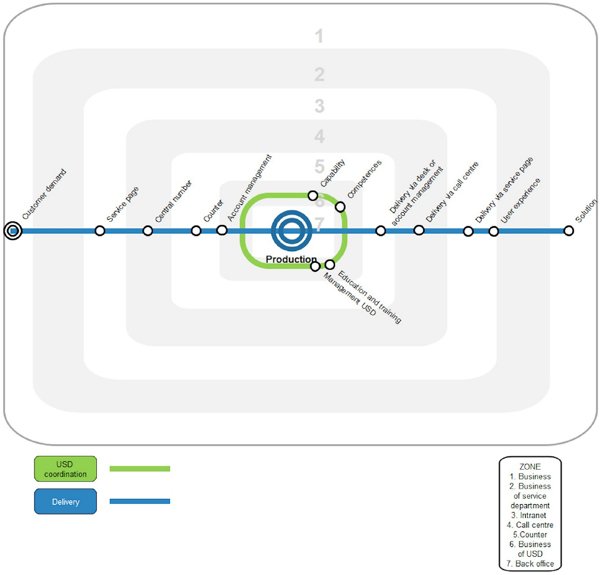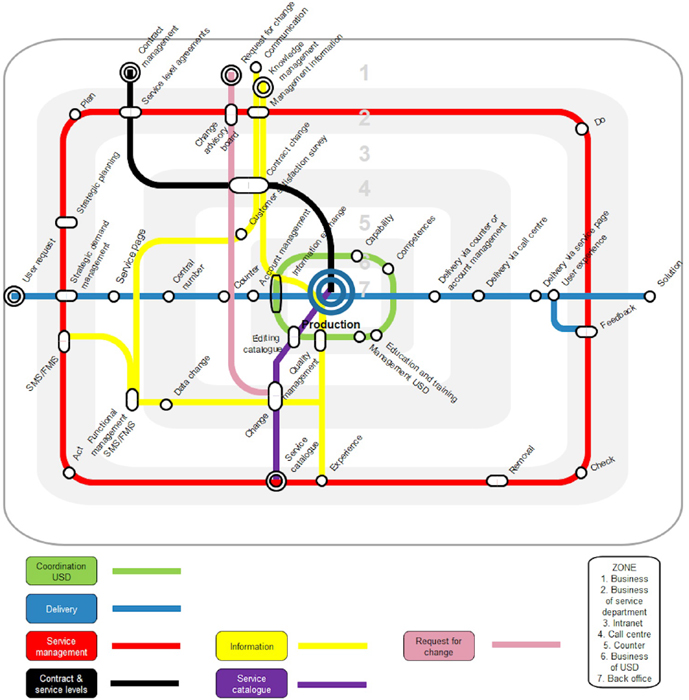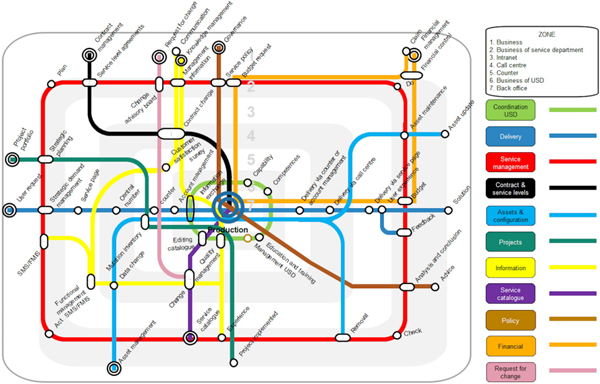CHAPTER 14: BUSINESS INFORMATION FOR THE USD
The USD can only function properly if it has the right information. Information should be both timely and accurate, so the USD must be well connected to various business processes served by the service and facilities organisation.
After reading this chapter, the reader will better understand what information the USD needs and how service management can ensure that the USD is connected to this information. A practical graphical diagram (‘metro map’, based on the London Underground concept by Harry Beck), is also described and with which these processes can be made visible in relation to the USD.
14.1 The USD within service management processes
As discussed in chapter 14, the proper organisation and optimisation of the service processes between the USD and back office is not sufficient to ensure good service. The USD need for information and data reaches further because the USD must be well aligned with the management and IT processes within the service organisation. In addition to the service process between customer and delivery, the USD depends on the management processes described in Table 14.1.
Table 14.1: Involvement of the USD in Management Processes
Management Processes |
Explanation |
Role of the USD |
Management and control |
The ‘plan, do, check, act’ circle of the service management process. |
The USD plays the central role in the operational services. The USD must work within these frameworks and principles. |
Incident management and delivery (delivery line) |
The service process from the USD to the back office, from notification to delivery. |
The process where the USD is central. |
Project management |
Initiating, executing, implementing and transferring projects. |
The USD must be aware of projects and it can assess reports. |
Management products and business and IT services (problem management) |
The aim is to determine the root cause of incidents that occur most often and to minimise the impact of incidents. |
The USD is the principal agent when several incidents have a cause in one underlying problem. |
Policy and strategy |
Principles and strategic management decisions that set the preconditions for service provision. |
The USD must consider applicable agreements and basic principles in its service provision. |
Financial management |
Strategic, tactical and operational (budgeting, invoice processing, compliance, etc.) of financial management. |
The USD must be aware of mandate and how costs and finances are settled operationally within the enterprise. |
Contract and SLA management (including supplier management) |
Contract management work from initiation to termination or re-tender. |
Service delivery takes place within the agreements established with suppliers. The USD must be aware of this. |
Knowledge management |
Information needed in the business organisation and IT: specific knowledge, experience and expertise; skills essential for the functioning of the primary process and the execution of the core task. |
This concerns basic knowledge that the business needs in order to fulfil the core tasks properly. If the USD understands this sufficiently, it can better assess reports in relation to their importance for the business. |
Assets and configuration management (means or asset management) |
Management of information about assets such as furniture, IT, pool cars, buildings, mechanical and electrical, building and automation components and their mutual relationships. |
The USD works with information systems (such as an SMS) and must be able to assume that the source data (assets and configuration) are correct. The USD can also pass on corrections or additions. |
Change management |
Manage requests and implement changes. |
The USD makes requests for changes to services, applications, various infrastructures and manages change procedures. |
The USD focuses mainly on operational information; information about the future, tactical and strategic information are not always directly relevant to the USD. The focus of the USD is providing immediate assistance to help the customer directly and correctly.
14.2 Metro map: graphic design of the USD and management processes
How do you get a grip on these processes in relation to the USD? Basically, you want to understand the position of the delivery process, and specifically the USD, in relation to the different information flows in your service organisation. Applying Table 14.1 and adapting for your specific USD is a first step. Information about the relationships and cohesion must then be described separately. It helps if in an overview of both the coherence and the different management processes in relation to a USD, can be represented in such a way that they form a single story. A diagram that is suitable for this and has proven itself is the ‘metro map’.
A first look at the complete metro map for the USD can intimidate you, but think about how you use a metro map in real life. If you are new to a city with a large metro system, at first you despair about how to travel from A to B. However, the logic of the subway map is that it is virtually the same throughout the world and it helps you to get to your destination. The power of this logic is that people generally understand it directly and can translate the chaotic reality into the abstract logic of the map. Harry Beck is the forgotten genius behind the concept. The basic principles of this map translate the chaos into a schematic and clear diagram where the perspective of the traveller (and in the case of the USD the customer), is leading.
A metro map of service delivery by a USD consists of seven different zones. We suggest these zones are:
• Zone 1 (outer zone): business – the customer organisation (the business of the enterprise).
• Zone 2: business of the service organisation.
• Zone 3: Internet/intranet – the third level of service (service portal).
• Zone 4: call centre – the second level of service (telephone, email and post).
• Zone 5: counter – the first level of USD service (physical, account management).
• Zone 6: business of the USD – the USD organisation (coordination of the USD).
• Zone 7: back office – back office with central management information as a node (inner zone).
First, sketch out the zones. Then, the management processes can be entered in the zones, the so-called ‘tracks’. The tracks listed in Table 14.2 are generic suggestions.
Table 14.2: Track of Management Processes
Management Processes |
Metro Map Track |
Management and control of service management |
Service management process |
Incident management and delivery (delivery line) |
Service process |
Project management |
Process of projects |
Business and IT management, products and services, problem management |
Process of problem management |
Policy and strategy |
Process of policy and strategy |
Financial management |
Process of financial management |
Contract and SLA management |
Process of SLA and contract management |
Knowledge management |
Process of knowledge management |
Assets and configuration management |
Process of asset management |
Change management |
Process of change management |
The tracks are drawn from the business zone that represents the business management processes in the enterprise, to the zone that is necessary for the service organisation to be able to work properly. The map is set up from the perspective of the USD, and therefore all the tracks cross the USD and the back office. In the middle is the junction where all essential service information must come together and then branch out. This often comprises core systems: SMS, any specific service desk (IT or otherwise) software, the security system and the personnel system.
The position of the USD is central because it is the core process; the service process from notification to delivery is drawn horizontally and extends from outer zone to outer zone, through every zone.
The ‘delivery line’ (![]() ) runs horizontally from left to right. Questions always emanate from the customer and will arise through the Internet/intranet, call centre, or counter/account management. Coordination (
) runs horizontally from left to right. Questions always emanate from the customer and will arise through the Internet/intranet, call centre, or counter/account management. Coordination (![]() ) takes place in the USD, and is processed, possibly passed on to the back office and then resolved. Delivery takes place as previously discussed via the Internet/intranet, call centre or perhaps in person.
) takes place in the USD, and is processed, possibly passed on to the back office and then resolved. Delivery takes place as previously discussed via the Internet/intranet, call centre or perhaps in person.
Figure 14.1: Delivery line and USD coordination
The stations represent the subprocesses; those activities that must be carried out in order to realise the management processes. Some stations indicate activities that can take place independently. At the larger stations, the lines cross each other and dependencies are identified (‘transfer stations’). Here, information is exchanged so that the processes can be executed correctly.
The USD is positioned within the service organisation. The general management process follows the PCDA cycle, as described earlier in this chapter (![]() ). Customers know which services they can request through the USD via the products and service catalogue (PDC), which is maintained by the service organisation. The service catalogue (
). Customers know which services they can request through the USD via the products and service catalogue (PDC), which is maintained by the service organisation. The service catalogue (![]() ) naturally fits within the agreed SLAs, OLAs and contracts (
) naturally fits within the agreed SLAs, OLAs and contracts (![]() ). New services or changed services are included via the change process (
). New services or changed services are included via the change process (![]() , request for adjustment) initiated from the customer organisation.
, request for adjustment) initiated from the customer organisation.
In order to provide the services, the USD needs the right information (![]() ), the basis of which is generally fixed in the SMS. The USD can only handle incidents in the right way if it has good information about the customer organisation (knowledge management).
), the basis of which is generally fixed in the SMS. The USD can only handle incidents in the right way if it has good information about the customer organisation (knowledge management).
Figure 14.2: Change request, service management and information on the delivery and service catalogue
Finally, the remaining processes can be addressed. The service must always be performed within the financial and policy frameworks (![]() and
and ![]() ). During delivery, the USD must have knowledge of the current projects, either because services have to be adjusted or so that they also provide services for the projects (
). During delivery, the USD must have knowledge of the current projects, either because services have to be adjusted or so that they also provide services for the projects (![]() ). The current state of affairs regarding assets (or configuration items) that are used for the services and the delivery of the services themselves (from furniture to building works, from requests for IT service access to the installation of new computing hardware, and anything in between that is in the purview of your USD), must be known (
). The current state of affairs regarding assets (or configuration items) that are used for the services and the delivery of the services themselves (from furniture to building works, from requests for IT service access to the installation of new computing hardware, and anything in between that is in the purview of your USD), must be known (![]() ). This leads to the complete picture of the USD.
). This leads to the complete picture of the USD.
Figure 14.3: Complete metro map for USD
14.3 Added value of the metro map
Information and data suppliers are continuously improving the quality of the information so that the quality of service to the users can also increase.
A graphic representation helps to:
• Identify dependencies between the USD and the different processes;
• Provide insight into the processes, the relationship between the processes and their components (subprocesses and tasks);
• Provide insight into the USD need for information and its type;
• Provide insight into the different dependencies relating to processes from the perspective of customer-oriented services;
• Illustrate (through the zones concept), that the USD supports the business (from outside and inside) and that it is not intended to be the centre of the universe;
• Identify choices that need to be simplified; and
• Better assess which processes have priority in improving the functioning of a USD (and therefore can show that sometimes improvement objectives for the USD are in unexpected areas).
14.4 Finally
Data or information management is the branch of knowledge concerned with maintaining and improving management processes. From the USD perspective, it is necessary to provide good service for insight into the basic information. As mentioned above, BiSLnext is a useful guide and training is available from certified trainers accredited by APMG (Johnson et al, 2018). This, of course, covers only a small but specific and important part of the total effort to maintain these processes.


